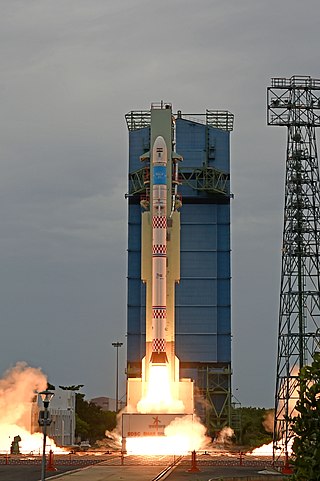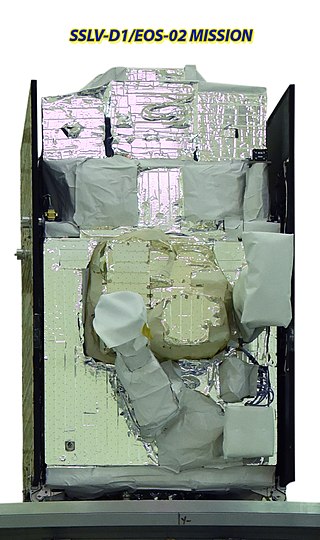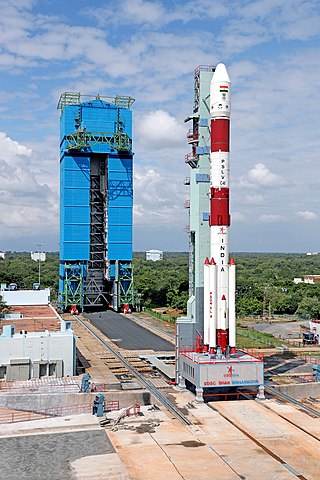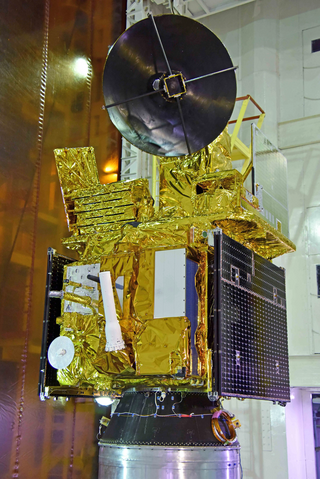Antrix Corporation Limited is an Indian government-owned company under the administrative control of the Department of Space. It was incorporated in September 1992, as a commercial and marketing arm of ISRO by prompting, commercially delivering and marketing products and services emanating from ISRO. It provides major technical consultancy services and transfers technologies to industry.

TecSAR-1, also known as TechSAR, Polaris and Ofeq-8, is an Israeli reconnaissance satellite, equipped with a synthetic-aperture radar (SAR) developed by Elta Systems. It was successfully launched at 03:45 UTC on 21 January 2008, by PSLV C-10 launch vehicle, from the Satish Dhawan Space Centre in India.

RISAT (Radar Imaging Satellite) is a series of Indian radar imaging reconnaissance satellites built by the Indian Space Research Organization (ISRO). They provide all-weather surveillance using synthetic aperture radars (SAR).
RISAT-2, or Radar Imaging Satellite-2 was an Indian radar imaging reconnaissance satellite that was part of India's RISAT programme. It was built by Indian Space Research Organisation (ISRO) and successfully launched aboard a PSLV-CA launch vehicle at 01:15:00 UTC on 20 April 2009 from the Second Launch Pad at the Satish Dhawan Space Centre.

Radar Imaging Satellite 1 or RISAT-1, was an Indian remote sensing satellite built and operated by the Indian Space Research Organisation (ISRO). The second RISAT satellite to be launched, it used a C-band 5.35 GHz synthetic-aperture radar (SAR) for Earth observation.

The NASA-ISRO Synthetic Aperture Radar (NISAR) mission is a joint project between NASA and ISRO to co-develop and launch a dual-frequency synthetic aperture radar on an Earth observation satellite. The satellite will be the first radar imaging satellite to use dual frequencies. It will be used for remote sensing, to observe and understand natural processes on Earth. For example, its left-facing instruments will study the Antarctic cryosphere. With a total cost estimated at US$1.5 billion, NISAR is likely to be the world's most expensive Earth-imaging satellite.

Geo Imaging Satellite or GISAT is an Indian imaging satellite class for geostationary orbit with a high temporal resolution, meant for providing near real time imaging with fast revisit capability and real time monitoring. Two satellites will provide resolution in the range of 42 to 318 m. It will carry multi-spectral, multi-resolution imaging instruments.

The Small Satellite Launch Vehicle (SSLV) is a small-lift launch vehicle developed by ISRO with payload capacity to deliver 500 kg (1,100 lb) to low Earth orbit or 300 kg (660 lb) to Sun-synchronous orbit for launching small satellites, with the capability to support multiple orbital drop-offs. SSLV is made keeping low cost, low turnaround time in mind with launch-on-demand flexibility under minimal infrastructure requirements.

PSLV-C42 was the 44th mission of the Indian Polar Satellite Launch Vehicle (PSLV) program and its 12th mission in the Core Alone (CA) configuration. PSLV-C42 successfully carried and deployed 2 Earth observation satellites in Sun-synchronous orbits at an altitude of 588 kilometres (365 mi). It was launched on 16 September 2018 by the Indian Space Research Organisation (ISRO) from the first launch pad of the Satish Dhawan Space Centre at Sriharikota, Andhra Pradesh. The two international satellites were launched as part of a commercial arrangement between Surrey Satellite Technology Limited (SSTL) and ISRO's commercial arm Antrix Corporation Limited, run under the auspices of the Indian Government's Department of Space.
RISAT-2B, or Radar Imaging Satellite-2B is an Indian radar reconnaissance satellite that is part of India's RISAT programme and the third satellite in the series. It is built by Indian Space Research Organisation (ISRO) to replace RISAT-2.

RISAT-2BR1 is a synthetic-aperture radar (SAR) imaging satellite built by Indian Space Research Organisation (ISRO). It is part of India's RISAT series of SAR imaging satellite and fourth satellite in the series. RISAT-2BR1 was launched on 11 December 2019 at 09:55 UTC aboard Polar Satellite Launch Vehicle PSLV-C48 from First Launch Pad (FLP) of Satish Dhawan Space Centre. It was the 50th launch of Polar Satellite Launch Vehicle and 75th launch from Satish Dhawan Space Centre.
EOS-01 is an X-band, synthetic-aperture radar (SAR) based all weather Earth imaging satellite built by the Indian Space Research Organisation (ISRO) for tasks pertaining to forestry, agricultural and disaster management. It is a part of India's RISAT series of SAR imaging spacecraft and would be third satellite in the series including RISAT-2B, RISAT-2BR1 with 120° phasing. EOS-01 has been developed at the cost of roughly ₹125 crore.

The PSLV-C52 is the 54th mission of the Indian Polar Satellite Launch Vehicle (PSLV) program. The Polar Satellite Launch Vehicle (PSLV)-C52 was launched at 05:59 (IST) on 14 February 2022 with the RISAT-1A(EOS-04), INSPIREsat, INS-2TD as its main payload.

EOS-02 was an Indian Earth observation microsatellite developed by the Indian Space Research Organisation as a test payload on the maiden launch of the Small Satellite Launch Vehicle (SSLV). EOS-02 was based on Microsat-TD. The objective behind EOS-02 was to realize and fly an experimental imaging satellite with short turnaround time to showcase launch on demand capability.

PSLV-C46 was a mission of the Indian Polar Satellite Launch Vehicle (PSLV) rocket, launched on Thursday, May 22, 2019, at 05:30 Hrs (IST) by the Indian Space Research Organisation (ISRO) from the first launch pad of the Satish Dhawan Space Centre at Sriharikota, Andhra Pradesh. In this mission, the 'Core-Alone' configuration of PSLV was flown.

PSLV-C47 was a mission of the Indian Polar Satellite Launch Vehicle (PSLV) rocket, launched on Thursday, November 27, 2019, at 09:27 Hrs (IST) by the Indian Space Research Organisation (ISRO) from the second launch pad of the Satish Dhawan Space Centre at Sriharikota, Andhra Pradesh.

PSLV-C48 was a mission of the Indian Polar Satellite Launch Vehicle (PSLV) rocket, launched on Thursday, December 11, 2019, at 15:25 Hrs (IST) by the Indian Space Research Organisation (ISRO) from the second launch pad of the Satish Dhawan Space Centre at Sriharikota, Andhra Pradesh.

Oceansat-3 is an Earth observation satellite, which is the third satellite in the Oceansat series launched by Indian Space Research Organisation (ISRO). It was launched on 26 Nov 2022, 06:26 UTC using a PSLV rocket from Satish Dhawan Space Centre, First Launch Pad (FLP). The satellite aims to improve the existing remote sensing capabilities related to the field of oceanography.














